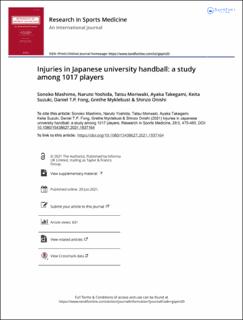Injuries in Japanese university handball: A study among 1017 players
Mashimo, Sonoko; Yoshida, Naruto; Moriwaki, Tatsu; Takegami, Ayaka; Suzuki, Keita; Fong, Daniel Tik-Pui; Myklebust, Grethe; Onishi, Shinzo
Peer reviewed, Journal article
Published version
Permanent lenke
https://hdl.handle.net/11250/2779888Utgivelsesdato
2021Metadata
Vis full innførselSamlinger
- Artikler / Articles [2119]
- Publikasjoner fra Cristin [1107]
Sammendrag
The aim of this study was to examine the injury profile of Japanese university handball players. In this cross-sectional study, a total of 1017 participants who played in the 2018 Japanese National University Handball Championship were followed. The incidence within the previous year was 0.59 [95% CI, confidence interval: 0.56–0.62] per player per year. The ankle (33.3%), knee (23.6%), and shoulder/clavicle (12.6%) were the body regions most affected by traumatic mechanisms, while the lumbar spine/lower back (26.0%), knee (15.7%), and shoulder (15.0%) were the body regions most affected by overuse mechanisms. Sprain (30.7%), ligamentous rupture (23.2%), and fracture (11.8%) were the main types of traumatic injuries, and stress fracture (25.0%) and lesion of meniscus or cartilage (25.0%) were the main types of overuse injuries. Female players were 1.5 times more likely (OR, odds ratio: 1.55 [95% CI: 1.20–2.01]) to experience an injury than their male counterparts, and line players were also 1.5 times more likely (OR: 1.49 [95% CI: 1.00–2.21]) to experience an injury than their wing counterparts. This study showed that there is a need for increased injury prevention efforts in Japanese handball, especially among female players.
Beskrivelse
This is an Open Access article distributed under the terms of the Creative Commons Attribution-NonCommercial-NoDerivatives License (http://creativecommons.org/licenses/by-nc-nd/4.0/), which permits non-commercial re-use, distribution, and reproduction in any medium, provided the original work is properly cited, and is not altered, transformed, or built upon in any way.
